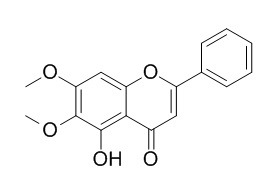Mosloflavone
Mosloflavanone is an antifungal and radical scavenging 2-hydroxyflavanone, it possesses strong anti-EV71 activity and decreased the formation of visible cytopathic effects, it also inhibits virus replication during the initial stage of virus infection, and inhibits viral VP2 protein expression, thereby inhibiting viral capsid protein synthesis. Mosloflavone shows promising anti-inflammatory activity via inhibition of TNF-α and IL-1β with IC50 values of 16.4 uM and 6.4 uM, respectively; it shows dose-dependent inhibition of TNF-α, IL-1β and iNOS levels in the supernatant of mouse macrophage cell line J774A, it also can be used as a starting point to discover lead structures for treatment of inflammatory and immunomodulatory diseases.
Inquire / Order:
manager@chemfaces.com
Technical Inquiries:
service@chemfaces.com
Tel:
+86-27-84237783
Fax:
+86-27-84254680
Address:
1 Building, No. 83, CheCheng Rd., Wuhan Economic and Technological Development Zone, Wuhan, Hubei 430056, PRC
Providing storage is as stated on the product vial and the vial is kept tightly sealed, the product can be stored for up to
24 months(2-8C).
Wherever possible, you should prepare and use solutions on the same day. However, if you need to make up stock solutions in advance, we recommend that you store the solution as aliquots in tightly sealed vials at -20C. Generally, these will be useable for up to two weeks. Before use, and prior to opening the vial we recommend that you allow your product to equilibrate to room temperature for at least 1 hour.
Need more advice on solubility, usage and handling? Please email to: service@chemfaces.com
The packaging of the product may have turned upside down during transportation, resulting in the natural compounds adhering to the neck or cap of the vial. take the vial out of its packaging and gently shake to let the compounds fall to the bottom of the vial. for liquid products, centrifuge at 200-500 RPM to gather the liquid at the bottom of the vial. try to avoid loss or contamination during handling.
Int J Cosmet Sci.2019, 41(1):12-20
Biomed Chromatogr.2022, 36(11):e5462.
Revista Brasileira de Farmacognosia2024, 34:1276-1286.
Biomolecules.2019, 9(11):E696
Int J Mol Sci.2023, 25(1):162.
Cell Chem Biol.2019, 26(1):27-34
Industrial Crops and Products2024, 129:119014
Nutrients.2023, 15(12):2810.
Front Immunol.2023, 14:1240800.
Dental Journal2024, 57(4): 254-258
Related and Featured Products
Biomol Ther (Seoul). 2016 Sep 1;24(5):552-8.
Inhibitory Effects of Norwogonin, Oroxylin A, and Mosloflavone on Enterovirus 71.[Pubmed:
27257010 ]
Severe complications associated with EV71 infections are a common cause of neonatal death. Lack of effective therapeutic agents for these infections underlines the importance of research for the development of new antiviral compounds.
METHODS AND RESULTS:
In the present study, the anti-EV71 activity of norwogonin, oroxylin A, and Mosloflavone from Scutellaria baicalensis Georgi was evaluated using a cytopathic effect (CPE) reduction method, which demonstrated that all three compounds possessed strong anti-EV71 activity and decreased the formation of visible CPEs. Norwogonin, oroxylin A, and Mosloflavone also inhibited virus replication during the initial stage of virus infection, and they inhibited viral VP2 protein expression, thereby inhibiting viral capsid protein synthesis. However, ribavirin has a relatively weaker efficacy compared to the other drugs.
CONCLUSIONS:
Therefore, these findings provide important information that will aid in the utilization of norwogonin, oroxylin A, and Mosloflavone for EV71 treatment.
Nat Prod Res. 2013;27(23):2227-30.
Anti-inflammatory and immunomodulatory flavones from Actinocarya tibetica Benth.[Pubmed:
23768253 ]
METHODS AND RESULTS:
Herein, we report the isolation and immunomodulatory activity of 11 phytoconstituents, viz. 7 flavonoids, 3 pentacyclic triterpenes and 1 phytosterol of an unexplored plant Actinocarya tibetica Benth. Three flavones, 5-methoxy-6,7-methylenedioxyflavone (6), Mosloflavone (7) and negletein (8), showed promising anti-inflammatory activity via inhibition of TNF-α and IL-1β with IC50 values of 0.22, 0.71, 16.4 μM and 10.8, 7.8, 6.4 μM, respectively. These flavones also showed dose-dependent inhibition of TNF-α, IL-1β and iNOS levels in the supernatant of mouse macrophage cell line J774A. Molecular modelling studies revealed orientation and interactions of flavones 6-8 in the active site of TNF-α.
CONCLUSIONS:
These flavones can be used as a starting point to discover lead structures for treatment of inflammatory and immunomodulatory diseases.
Zhong Yao Cai. 2015 Jan;38(1):89-92.
Chemical Constituents with Anti-hypoxia Activity from Saussurea involucrata.[Pubmed:
26214875]
To investigate the chemical constituents with anti-hypoxia activity from Saussurea involucrata.
METHODS AND RESULTS:
The chemical constituents, isolated and purified by column chromatography from Saussurea involucrata, were identified by several spectroscopic methods. The anti-hypoxic activities of these compounds were examined using the normobaric hypoxic model of mice.
Twelve compounds were isolated from petroleum ether extract of Saussurea involucrata and identified as n-octacosane (1), 1-undecanol (2), heptadecan-l-ol(3), heptacosan-1-ol(4), myristicin (5), apiol(6), β-sitosterol(7), lupeol(8), moslosooflavone (9), Mosloflavone (10), negletein(11), and 5, 6-dihydroxy-7, 8-dimethoxyflavone(12).
CONCLUSIONS:
All compounds except 7 and 8 are isolated from this plant for the first time. Compound 1, 5 and 8 - 12 can significantly prolong the survival time of hypoxic mice.
Planta Med. 1999 Dec;65(8):729-31.
A new 2-hydroxyflavanone from Mosla soochouensis.[Pubmed:
17260299]
METHODS AND RESULTS:
A new antifungal and radical scavenging 2-hydroxyflavanone, named mosloflavanone, was isolated from the dichloromethane extract of Mosla soochouensis together with the known Mosloflavone and moslosooflavone.
CONCLUSIONS:
Structures were established by spectroscopic and chemical methods, as well as X-ray crystallography.



